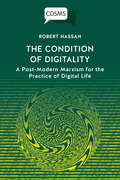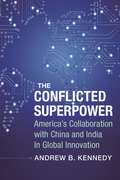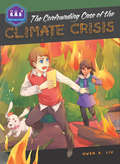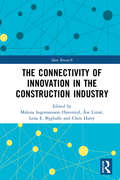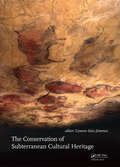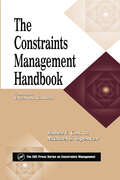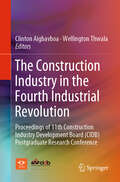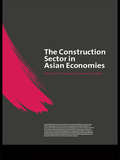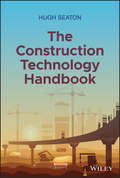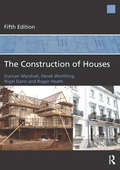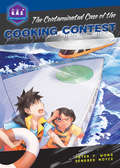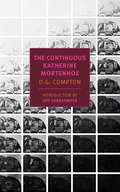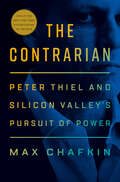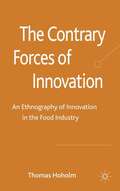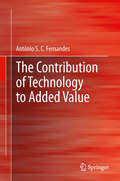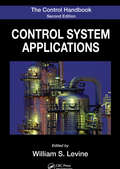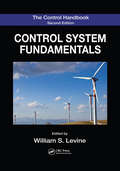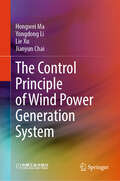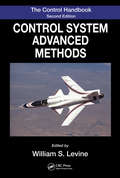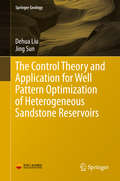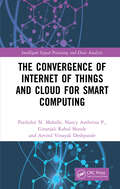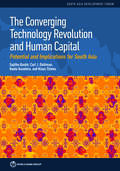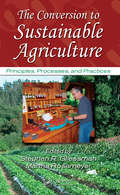- Table View
- List View
The Condition of Digitality: A Post-Modern Marxism for the Practice of Digital Life (Critical Digital and Social Media Studies #2517-1623)
by Robert HassanDavid Harvey’s The Condition of Postmodernity rationalised capitalism’s transformation during an extraordinary year: 1989. It gave theoretical expression to a material and cultural reality that was just then getting properly started – globalisation and postmodernity – whilst highlighting the geo-spatial limits to accumulation imposed by our planet. However this landmark publication, author Robert Hassan argues, did not address the arrival of digital technology, the quantum leap represented by the move from an analogue world to a digital economy and the rapid creation of a global networked society. Considering first the contexts of 1989 and Harvey’s work, then the idea of humans as analogue beings he argues this arising new human condition of digitality leads to alienation not only from technology but also the environment. This condition he suggests, is not an ideology of time and space but a reality stressing that Harvey’s time-space compression takes on new features including those of ‘outward’ and ‘inward’ globalisation and the commodification of all spheres of existence. Lastly the author considers culture’s role drawing on Rahel Jaeggi’s theories to make the case for a post-modern Marxism attuned to the most significant issue of our age. Stimulating and theoretically wide-ranging The Condition of Digitality recognises post-modernity’s radical new form as a reality and the urgent need to assert more democratic control over digitality.
The Conflicted Superpower: America’s Collaboration with China and India in Global Innovation (A Nancy Bernkopf Tucker and Warren I. Cohen Book on American–East Asian Relations)
by Andrew KennedyFor decades, leadership in technological innovation has sustained U.S. power worldwide. Today, however, processes that undergird innovation increasingly transcend national borders. Cross-border flows of brainpower have reached unprecedented heights, while multinationals invest more and more in high-tech facilities abroad. In this new world, U.S. technological leadership increasingly involves collaboration with other countries. China and India have emerged as particularly prominent partners, most notably as suppliers of intellectual talent to the United States. In The Conflicted Superpower, Andrew Kennedy explores how the world’s most powerful country approaches its growing collaboration with these two rising powers.Whereas China and India have embraced global innovation, policy in the United States is conflicted. Kennedy explains why, through in-depth case studies of U.S. policies toward skilled immigration, foreign students, and offshoring. These make clear that U.S. policy is more erratic than strategic, the outcome of domestic battles between competing interests. Pressing for openness is the “high-tech community”—the technology firms and research universities that embody U.S. technological leadership. Yet these pro-globalization forces can face resistance from a range of other interests, including labor and anti-immigration groups, and the nature of this resistance powerfully shapes just how open national policy is. Kennedy concludes by asking whether U.S. policies are accelerating or slowing American decline, and considering the prospects for U.S. policy making in years to come.
The Confounding Case of Climate Crisis
by Owen R. Liu Barbara TinkerWith time travel and mysteries that need solving, the Galactic Academy of Science (G.A.S.) series instructs readers on how to think like scientists. Under the guidance of a Dude or Dudette from the future, the middle school characters are faced with treacherous, present-day crimes that require a historical knowledge of science in order to be solved. From investigating problems to analyzing data and constructing explanations and solutions, this series blends elements of sci-fi with educational methods that distill the key thinking habits of scientists and engineers. An adventure that investigates the causes and consequences of climate change Something strange is going on during Anita and Benson's field trip to a greenhouse as their guide is making wild claims about carbon dioxide and their science teacher, Mr. Fazmel, has mysteriously disappeared. That's when Quarkum Phonon, a Dude from the future, sends Anita and Benson on a Galactic Academy of Science mission to learn about the origins of climate change and the ways communities around the world are dealing with its impact. With stops around the world--from a Hawaiian volcano to Greenland and Geneva--Anita and Benson sift through the evidence for climate change. On their return home, the students face the question: what can a couple of kids do to reduce CO2 emissions and slow down climate change? A portion of all profits from this book will go to support local projects helping people in the developing world adapt to climate change.
The Connectivity of Innovation in the Construction Industry (Spon Research)
by Malena Ingemansson Havenvid Åse Linné Lena E. Bygballe Chris HartyThe construction industry is currently experiencing accelerating developments concerning societal demands along with project complexity, internationalization and digitalization. In an attempt to grasp the consequences of these demands on productivity and innovation, this edited book addresses how innovation is likely to take place with a more long-term perspective on the construction sector. While existing literature focuses on organizational discontinuity and fragmentation as the main reasons for the apparent lack of innovation in the industry, this book highlights the connectivity of construction actors, resources and activities as fundamental for understanding how innovation takes place.Through 15 empirically grounded chapters, the book shows how innovation is part of construction processes on various levels, including project, firm and industry, and that these innovation processes are characterized by organizational and technological connectivity over time. Written by European business management scholars, the chapters cover empirical cases and examples from both a multi-organizational and a multi-international perspective in terms of covering the viewpoints of different industry actors and the contexts of several different European countries including: Sweden, Norway, the UK, Italy, France, Hungary and Poland. By illustrating how connectivity is part of innovation processes in the creation of single-product innovations, of various innovations within and across projects, as well as a fundamental aspect of the processes in which innovations cross nations, the book provides a new angle on how to understand construction innovation and where the industry might (or needs to) be heading next. This book is essential reading for anyone interested in construction management, project management, engineering management, innovation studies, business and management studies.
The Conquest of Viruses: A History of Viral Vaccines
by Van G. WilsonThis book guides through the fascinating history of viral vaccines, from the first primitive smallpox vaccination in the 18th century to the cutting-edge RSV formulation approved in 2023. Each chapter delves into the scientific, clinical, and social forces that led to the development of these life-saving medical innovations, highlighting the scientists who played pivotal roles. With a focus on making complex science accessible and history engaging, this book offers a comprehensive portrayal of virology, vaccinology and the interplay between science and society in shaping public health. Readers will explore key concepts such as the evolution of vaccine technology over time, from cowpox material to mRNA vaccines, and a wide array of other topics, including the eradication of diseases through vaccines, the challenges of immunization against influenza, and the revolutionary impact of COVID-19 vaccination. The author, microbiologist Professor Wilson, provides expert analysis on how sociological factors influenced vaccine progress and gets to the bottom of the question of why there is still no vaccine for some critical diseases. This book is a must-read for anyone with an interest in viruses and vaccines. Whether you're a researcher or simply fascinated by medical history, this book promises to be both informative and entertaining.
The Conservation of Subterranean Cultural Heritage
by Cesareo Saiz-JimenezThis proceedings volume contains selected papers presented at the Workshop on the Conservation of the Subterranean Cultural Heritage, held 25-27 March 2014, in Seville, Spain. The workshop was organized by the Spanish Network of Science and Technology for the Conservation of Cultural Heritage (TechnoHeritage). Contributions cover the following fields: archaeology, history, conservation, maintenance and restoration, architectural sciences and engineering.
The Constraints Management Handbook (The CRC Press Series on Constraints Management)
by Michael S. Spencer III CoxA new approach to improving the production of goods and services, Constraints Management (CM), recognizes the powerful role of the constraint (the limiting resource) in determining the output of the entire production system. By learning about and mastering CM concepts, managers can improve their companies' present output and plan for future growth as well.
The Construction Alphabet Book (Jerry Pallotta's Alphabet Books)
by Jerry PallottaFor fans of all things that go this noisy alphabet book explores construction equipment from A to Z. Find out about these construction machines and more, from a huge saw that cuts through roads to a massive vacuum that sucks up boulders. You'll even learn a quick and easy recipe for concrete. Rock crushers, jackhammers, and wrecking balls will delight the youngest of readers learning their ABCs. Jerry Pallotta's trademark humor punctuates the informative text. Vibrant oil paintings bring to life a busy construction site.
The Construction Industry in the Fourth Industrial Revolution: Proceedings of 11th Construction Industry Development Board (CIDB) Postgraduate Research Conference
by Clinton Aigbavboa Wellington ThwalaThis book gathers papers from the 11th Construction Industry Development Board (cidb) Postgraduate Research Conference, held on 28–30 July 2019 in Johannesburg, South Africa. The conference provided an essential forum for reviewing and generating knowledge on Construction 4.0 and, consequently, highlighted processes and practices that allow us to deliver and operate built environment assets more effectively and efficiently by focusing on physical-to-digital and digital-to-physical transformation. The event addressed three broad themes: Industrial production (prefabrication, 3-D printing and assembly, offsite and advanced manufacturing);Cyber-physical systems (actuators, sensors, IoT, robots and cobots for repetitive and dangerous tasks, and drones for mapping, progress monitoring, safety and quality inspections, lifting, moving and positioning); and Technologies (digital ecosystems, digital platforms, BIM, video and laser scanning, AI and cloud computing, big data and data analytics, reality capture, blockchain, simulation, virtual and augmented reality, data standards and interoperability, and vertical and horizontal integration). Given its scope, the book will be of interest to all construction industry and architectural professionals who want to learn about cutting-edge technologies applied to construction
The Construction Sector in the Asian Economies
by John Raftery Michael Anson Y.H. ChiangThis collection of essential data on eleven Asian economies outlines new trends and highlighting increasing differences between developed and developing countries. The book features a detailed analysis of the state of the construction industry and its economic effects in Australia, China Mainland, China Hong Kong, India, Indonesia, Japan, South Korea, Philippines, Singapore, Sri Lanka and Vietnam.
The Construction Technology Handbook
by Hugh SeatonTired of new software that doesn’t seem to work in the field? Ready to get your teams up to speed and productive with the latest tools? The Construction Technology Handbook takes a ground up, no jargon look at technology in the construction industry. From clear, quickly grasped explanations of how popular software actually works to how companies both large and small can efficiently try out and onboard new tools, this book unlocks new ways for construction field teams, firm owners, managers, leaders, and employees to do business. You’ll learn about: Simple frameworks for making sense of all the new options cropping up How software and data work and how they work together to make your job easier and safer What artificial intelligence really is and how it can help real companies today Tools that are just over the horizon that will, one day, make your job just a little bit easier New and practical resources to help you incorporate an attitude of innovation and technology adoption into your workplace Perfect for general contractors and subcontractors, The Construction Technology Handbook also belongs on the bookshelves of construction technology vendors and construction workers who want to better understand the needs of the construction industry and the inner workings of construction technology, respectively.
The Construction of Houses
by Derek Worthing Duncan Marshall Roger Heath Nigel DannThe fifth edition of this successful textbook is aimed specifically at those students and practitioners who require a broad understanding of building construction as part of a wider sphere of professional activity. The book provides a comprehensive introduction to the principles and practice of modern construction and services. New to this edition are: Hundreds of revised graphics to complement the fully updated text New illustrations and photos printed in full colour for the first time New chapters on sustainability, ventilation and windows. This highly sought after text concentrates on principles and practice rather than details and regulations and retains it’s easy to follow format and highly accessible style. In doing so it enables the reader to demonstrate a comprehensive and genuine understanding of modern house construction and its evolution over the last 100 years. The Construction of Houses is not only an essential read for students, surveyors, developers and planning professionals, but also the interested lay person considering their first building project.
The Contaminated Case of Cooking Contest
by Peter WongWith time travel and mysteries that need solving, the Galactic Academy of Science (G.A.S.) series instructs readers on how to think like scientists. Under the guidance of a Dude or Dudette from the future, the middle school characters are faced with treacherous, present-day crimes that require a historical knowledge of science in order to be solved. From investigating problems to analyzing data and constructing explanations and solutions, this series blends elements of sci-fi with educational methods that distill the key thinking habits of scientists and engineers. The science of food safety combines with mystery in this G.A.S. adventure about an outbreak of foodborne illness When a cruise featuring a cooking contest turns into a disaster of vomiting passengers, seventh-grade G.A.S. trainees Mae and Clinton have a mystery to solve. With help from Selectra Volt, Dudette from the future, the two kids travel through time to learn about the science of food safety. Between journeys to the past, they investigate clues aboard ship. But when a storm comes, and conditions aboard the disabled ship become desperate, can Mae and Clinton discover the cause of the outbreak in time?
The Continuous Katherine Mortenhoe
by D. G. Compton Jeff VandermeerKatherine Mortenhoe lives in a near future very similar to the present day. Only in her time, dying from anything but old age is unheard of; death has been cured. So when Katherine is diagnosed with a terminal brain disease brought on by an inability to process an ever increasing volume of sensory input, she immediately becomes a celebrity to the "pain-starved public." But Katherine rejects her tragic role: She will not agree to be the star of a Human Destiny TV show, her last days will not be documented or broadcast. What she doesn't realize is that from the moment of diagnosis she's been watched, not only by television producers but by a new kind of program host, a man with a camera behind his unsleeping eyes.Like Margaret Atwood's MaddAddam trilogy, Kazuo Ishiguro's Never Let Me Go, and the television series Black Mirror, The Continuous Katherine Mortenhoe is a thrilling psychological drama that is as wise about human nature as it is about the nature of technology.
The Contrarian: Peter Thiel and Silicon Valley's Pursuit of Power
by Max ChafkinA biography of venture capitalist and entrepreneur Peter Thiel, the enigmatic, controversial, and hugely influential power broker who sits at the dynamic intersection of tech, business, and politics &“Max Chafkin&’s The Contrarian is much more than a consistently shocking biography of Peter Thiel, the most important investor in tech and a key supporter of the Donald Trump presidency. It&’s also a disturbing history of Silicon Valley that will make you reconsider the ideological foundations of America&’s relentless engine of creative destruction.&”—Brad Stone, author of The Everything Store and Amazon UnboundSince the days of the dot-com bubble in the late 1990s, no industry has made a greater impact on the world than Silicon Valley. And few individuals have done more to shape Silicon Valley than Peter Thiel. The billionaire venture capitalist and entrepreneur has been a behind-the-scenes operator influencing countless aspects of our contemporary way of life, from the technologies we use every day to the delicate power balance between Silicon Valley, Wall Street, and Washington. But despite his power and the ubiquity of his projects, no public figure is quite so mysterious.In the first major biography of Thiel, Max Chafkin traces the trajectory of the innovator's singular life and worldview, from his upbringing as the child of immigrant parents and years at Stanford as a burgeoning conservative thought leader to his founding of PayPal and Palantir, early investment in Facebook and SpaceX, and relationships with fellow tech titans Mark Zuckerberg, Elon Musk, and Eric Schmidt. The Contrarian illuminates the extent to which Thiel has sought to export his values to the corridors of power beyond Silicon Valley, including funding the lawsuit that destroyed the blog Gawker and strenuously backing far-right political candidates, notably Donald Trump for president in 2016. Eye-opening and deeply reported, The Contrarian is a revelatory biography of a one-of-a-kind leader and an incisive portrait of a tech industry whose explosive growth and power is both thrilling and fraught with controversy.
The Contrary Forces of Innovation
by Thomas HoholmThe complexity and tensions of industrial innovation processes are fleshed out through the analysis of an intriguing case study from the food industry. Drawing together insights from multiple disciplines, this book shows the controversial nature of innovation processes.
The Contribution of Technology to Added Value
by António S.C FernandesThere is a wide consensus that introduction of technology to the production process contributes to an overall economic value, however, confusion between technology, knowledge and capital often makes value calculations ambiguous and non-objective. The Contribution of Technology to Added Value addresses not only this issue of definition but also provides a production model to assess the value contribution of technology within the production process. A clarification of fundamental semantics provides a significant taxonomy for technology dependence, and allows understanding and modeling of how knowledge, technology and capital individually contribute to production and to value adding. A new technology dependence taxonomy is proposed and assessed following chapters explaining growth models, the KTC model and technology index values. Balancing theoretical knowledge with real-world data and applications The Contribution of Technology to Added Value clarifies the issue of value adding for a range of different viewpoints and purposes; from academic to industry and service across engineering, economics and management.
The Control Handbook: Control System Applications, Second Edition (The Electrical Engineering Handbook)
by William S. LevineAt publication, The Control Handbook immediately became the definitive resource that engineers working with modern control systems required. Among its many accolades, that first edition was cited by the AAP as the Best Engineering Handbook of 1996. Now, 15 years later, William Levine has once again compiled the most comprehensive and authoritative resource on control engineering. He has fully reorganized the text to reflect the technical advances achieved since the last edition and has expanded its contents to include the multidisciplinary perspective that is making control engineering a critical component in so many fields.Now expanded from one to three volumes, The Control Handbook, Second Edition organizes cutting-edge contributions from more than 200 leading experts. The second volume, Control System Applications, includes 35 entirely new applications organized by subject area. Covering the design and use of control systems, this volume includes applications for: Automobiles, including PEM fuel cells Aerospace Industrial control of machines and processes Biomedical uses, including robotic surgery and drug discovery and development Electronics and communication networks Other applications are included in a section that reflects the multidisciplinary nature of control system work. These include applications for the construction of financial portfolios, earthquake response control for civil structures, quantum estimation and control, and the modeling and control of air conditioning and refrigeration systems.As with the first edition, the new edition not only stands as a record of accomplishment in control engineering but provides researchers with the means to make further advances. Progressively organized, the other two volumes in the set include: Control System Fundamentals Control System Advanced Methods
The Control Handbook: Control System Fundamentals, Second Edition (Electrical Engineering Handbook)
by William S. LevineAt publication, The Control Handbook immediately became the definitive resource that engineers working with modern control systems required. Among its many accolades, that first edition was cited by the AAP as the Best Engineering Handbook of 1996. Now, 15 years later, William Levine has once again compiled the most comprehensive and authoritative resource on control engineering. He has fully reorganized the text to reflect the technical advances achieved since the last edition and has expanded its contents to include the multidisciplinary perspective that is making control engineering a critical component in so many fields. Now expanded from one to three volumes, The Control Handbook, Second Edition brilliantly organizes cutting-edge contributions from more than 200 leading experts representing every corner of the globe. The first volume, Control System Fundamentals, offers an overview for those new to the field but is also of great value to those across any number of fields whose work is reliant on but not exclusively dedicated to control systems. Covering mathematical fundamentals, defining principles, and basic system approaches, this volume: Details essential background, including transforms and complex variables Includes mathematical and graphical models used for dynamical systems Covers analysis and design methods and stability testing for continuous-time systems Delves into digital control and discrete-time systems, including real-time software for implementing feedback control and programmable controllers Analyzes design methods for nonlinear systems As with the first edition, the new edition not only stands as a record of accomplishment in control engineering but provides researchers with the means to make further advances. Progressively organized, the other two volumes in the set include: Control System Applications Control System Advanced Methods
The Control Principle of Wind Power Generation System
by Hongwei Ma Yongdong Li Lie Xu Jianyun ChaiThe book focuses on wind power generation systems. The control strategies have been addressed not only on ideal grid conditions but also on non-ideal grid conditions, which are more common in practice, such as kinds of asymmetrical grid conditions and weak grid conditions. This is achieved by providing in-depth study on a number of major topics such as mathematical models, modeling methods, dynamic characteristics on ideal grid condition and non-ideal grid conditions, advanced control strategies, and novel topologies. The comprehensive and systematic elaboration of wind power systems by a large number of original simulations and experimental results from the authors’ research group is one of the major features of the book, which is particularly suited for readers who are interested in learning practical solutions to wind power systems. The book benefits researchers, engineers, graduate students, and senior undergraduate students in fields of electrical engineering, power electronics, wind power generation, etc.
The Control Systems Handbook: Control System Advanced Methods, Second Edition (ISSN)
by William S. LevineAt publication, The Control Handbook immediately became the definitive resource that engineers working with modern control systems required. Among its many accolades, that first edition was cited by the AAP as the Best Engineering Handbook of 1996. Now, 15 years later, William Levine has once again compiled the most comprehensive and authoritative resource on control engineering. He has fully reorganized the text to reflect the technical advances achieved since the last edition and has expanded its contents to include the multidisciplinary perspective that is making control engineering a critical component in so many fields. Now expanded from one to three volumes, The Control Handbook, Second Edition organizes cutting-edge contributions from more than 200 leading experts. The third volume, Control System Advanced Methods, includes design and analysis methods for MIMO linear and LTI systems, Kalman filters and observers, hybrid systems, and nonlinear systems. It also covers advanced considerations regarding — Stability Adaptive controls System identification Stochastic control Control of distributed parameter systems Networks and networked controls As with the first edition, the new edition not only stands as a record of accomplishment in control engineering but provides researchers with the means to make further advances. Progressively organized, the first two volumes in the set include: Control System Fundamentals Control System Applications
The Control Theory and Application for Well Pattern Optimization of Heterogeneous Sandstone Reservoirs
by Jing Sun Dehua LiuThe book is focused primarily on characteristics and determinative methods of reservoir orientation, the concept of vector well pattern and corresponding realistic techniques of well pattern deployment, well pattern control principles, Optimum design of well pattern based on the reservoir direction characteristics, and the schemes of well spacing density regulation at different stages of development. The procedures for improving water flooding efficiency have been provided. This book is suitable for reservoir engineering managers, reservoir engineers, and students of petroleum engineering.
The Convergence of Internet of Things and Cloud for Smart Computing (Intelligent Signal Processing and Data Analysis)
by Parikshit N. Mahalle Gitanjali Rahul Shinde Nancy Ambritta P. Arvind Vinayak DeshpandeThis book presents the know-how of the real-time IoT application development activity including a basic understanding of the IoT architecture, use cases, smart computing, and the associated challenges in design and development of the IoT system. All the technical details related to protocol stack, technologies, and platforms used for the implementation are explained. It further includes techniques and case studies that include smart computing on the IoT–Cloud models along with test beds for experimentation purposes. The book aims at setting up the groundwork for the creation of applications that can help make day-to-day tasks simpler by meeting the needs of varied sectors like education, health care, agriculture, and so forth. Features: • Covers IoT cloud convergence with a focus on complex industrial IoT case studies. • Discusses the broad background of IoT–Cloud convergence architectures and its fundamentals along with resource provisioning mechanisms. • Emphasizes the use of context in developing context-aware IoT solutions. • Presents a novel C-model that explains the IoT application development phases. • Discusses a simplified convergence model that depicts the role of Cloud in an IoT application. This book aims at graduate students, researchers, and professionals getting started in the IoT field.
The Converging Technology Revolution and Human Capital: Potential and Implications for South Asia (South Asia Development Forum)
by Sajitha Bashir Carl Dahlman Naoto Kanehira TilmesSouth Asia is heavily impacted by the devastating loss of lives and human capital from the COVID-19 pandemic and the converging technology revolution sweeping the globe. The Converging Technology Revolution and Human Capital: Potential and Implications for South Asia looks at how the region could capitalize on these technologies to accelerate its development of human capital and promote adaptability and resilience to future shocks. The convergence of technological breakthroughs spanning biotechnology, nanotechnology, information technology, and cognitive science is driven by artificial intelligence, data flows, computing power, and connectivity. These breakthroughs can improve service delivery, productivity, and innovation, but they can also exacerbate inequalities and eliminate people’s agency and empowerment. This report analyzes these trends in the region, offering a comprehensive agenda to exploit the opportunities offered by converging technologies while minimizing the risks to vulnerable populations. It proposes strategies for building public sector capacity and promoting data and technology governance frameworks in a rapidly evolving technology landscape.
The Conversion to Sustainable Agriculture: Principles, Processes, and Practices (Advances in Agroecology)
by Stephen R. Gliessman Martha RosemeyerWith all of the environmental and social problems confronting our food systems today, it is apparent that none of the strategies we have relied on in the pasthigher-yielding varieties, increased irrigation, inorganic fertilizers, pest damage reductioncan be counted on to come to the rescue. In fact, these solutions are now part of the problem. It i
